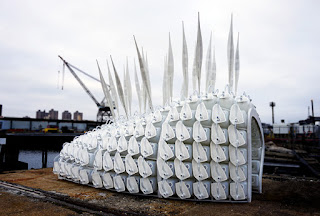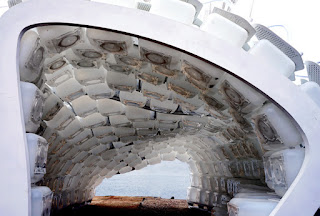The MIT
Center for Advanced Urbanism believes it is time to explore how the suburbs may
be improved through better design and planning. What new land tenure models are
needed to ensure that suburbs will become the frontier of innovation, tapping
into flexible land-use to enable experimental economies, programs, and
building? What technological innovations and productive systems will be
embedded within suburban development to allow for self-sufficiency, or even
perhaps to become a net producer of food, water, and energy? How do new forms
of suburbs in these contexts evolve over time? The Future of
Suburbia conference will outline four design frameworks that project a future
that is heterogeneous, experimental, autonomous and productive. Each of these
themes will be explored by panelists from a broad array of fields including:
design, architecture, urban planning, history and demographics, policy, energy,
mobility, health, environment, economics, and applied and future technologies. https://issuu.com/sienascarff/docs/caufosprogramfinalissuu http://cau.mit.edu/conference/future-suburbia
3.29.2016
3.27.2016
Cricket Shelter - Modular Edible Insect Farm and Survival Habitat
The continuous impact of
climate dynamics, armed conflicts, non-stop urbanization and
economic upheavals present a distinct need for a hybrid architectural
topology to deliver parallel solutions for food and shelter in each distressed
region. This is a dual-purpose shelter and modular insect farm
bounded into one structure. It’s intended for the impending food crisis,
where people will need access to good sources of alternative protein,
as raising livestock is not possible at our current rate of consumption
and resource extraction. The United Nations has mandated insect sourced
protein is a major component to solving global food distribution problems. This arguably impacts the diets of all
peoples across the globe.
In an advanced economic setting, this farm can introduce a sophisticated and ultra-sanitary method of locally harvesting insects for the production of cricket flour in fine cuisine recipes. It can also serve to be a new topology for a specialty restaurant, eatery, storehouse or similar architectural program. Introducing crickets into the modern American/ European diet is not a simple task, but there is precedent. For example, a few decades ago American’s did not wish to eat raw fish. Yet positive change materialized after sushi was introduced on a culturally refined and hygienic level. The same kind of approach needs to be embedded in the cultivation of crickets to achieve the cleanliness, quality, and purity of the farm-to-table system. Over two billion people eat insects every day; it’s time to reintroduce them into the diets of the remaining population.
Raising cattle, pigs, and chicken for meat products all require immense amounts of fresh water. Harvesting insects for food typical takes three hundred times less water for the same amount of protein. Our project aims to maximize access to nutrient resources and to deal with and support local communities in anticipation of post-disaster scenarios. This also targets societal upgrading strategies in both
developed and developing countries as the temporary shelter easily coverts to a permanent farming system/ eatery after the crisis has dissipated.
In an advanced economic setting, this farm can introduce a sophisticated and ultra-sanitary method of locally harvesting insects for the production of cricket flour in fine cuisine recipes. It can also serve to be a new topology for a specialty restaurant, eatery, storehouse or similar architectural program. Introducing crickets into the modern American/ European diet is not a simple task, but there is precedent. For example, a few decades ago American’s did not wish to eat raw fish. Yet positive change materialized after sushi was introduced on a culturally refined and hygienic level. The same kind of approach needs to be embedded in the cultivation of crickets to achieve the cleanliness, quality, and purity of the farm-to-table system. Over two billion people eat insects every day; it’s time to reintroduce them into the diets of the remaining population.
Raising cattle, pigs, and chicken for meat products all require immense amounts of fresh water. Harvesting insects for food typical takes three hundred times less water for the same amount of protein. Our project aims to maximize access to nutrient resources and to deal with and support local communities in anticipation of post-disaster scenarios. This also targets societal upgrading strategies in both
developed and developing countries as the temporary shelter easily coverts to a permanent farming system/ eatery after the crisis has dissipated.
Structurally, the shelter can be minimized into easily
manufactured and replicable elements such as a simple CNC plywood
archway with linked off-the-shelf plastic containers as infill
surface. The current version of the structure is more customized
to account for solar orientation, airflow and varied spatial
programs internally. A computational model was used to parametrically
align all of the individual containers to match the archway splines.
Each pre-ordered container was modified to add ventilation screens,
flexible insect sacks, locally controlled louvers, and permeable
feeder ports with rotating locking mechanisms. The wind quill
ventilation component magnifies the sound of cricket chirping in columns of
vibrating air.
The scheme has a multipronged focus on
international hunger solutions, sustainable food distribution methods
and modular compact architecture. A project of this type is built for
areas in calamitous need both present and future. We understand that our
role in the complex system of global cooperation is to seek
holistic solutions that integrate interdisciplinary knowledge
and citizen participation for shelter and subsistence farming. It is
essential to understand the physical, social and cultural substrate
of developing territories in which food and refuge is simultaneously
critical.
Credits: Terreform ONE, Mitchell Joachim (PI), Maria Aiolova, Felipe Molina, Matthew Tarpley, Melanie Fessel, Jiachen Xu, Lissette Olivares, Cheto Castellano, Shandor Hassan, Christian Hamrick, Ivan Fuentealba, Sung Moon, Kamila Varela, Yucel Guven, Chloe Byrne, Miguel Lantigua-Inoa
Sponsor: Art Works for Change.
http://www.mediafire.com/download/4g44p39nuk14hcc/TerreformONE_CricketShelter.pdf
Subscribe to:
Comments (Atom)












